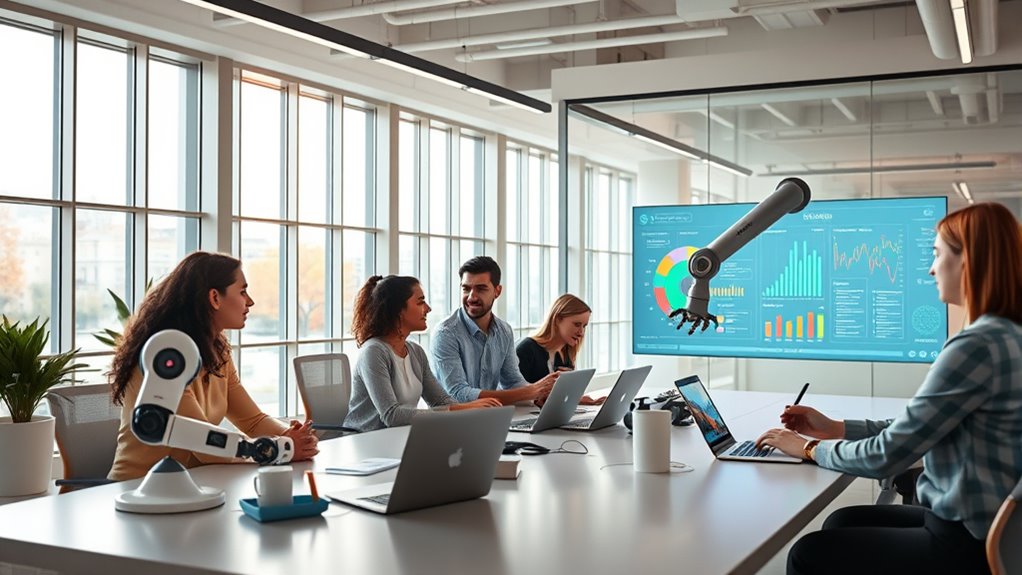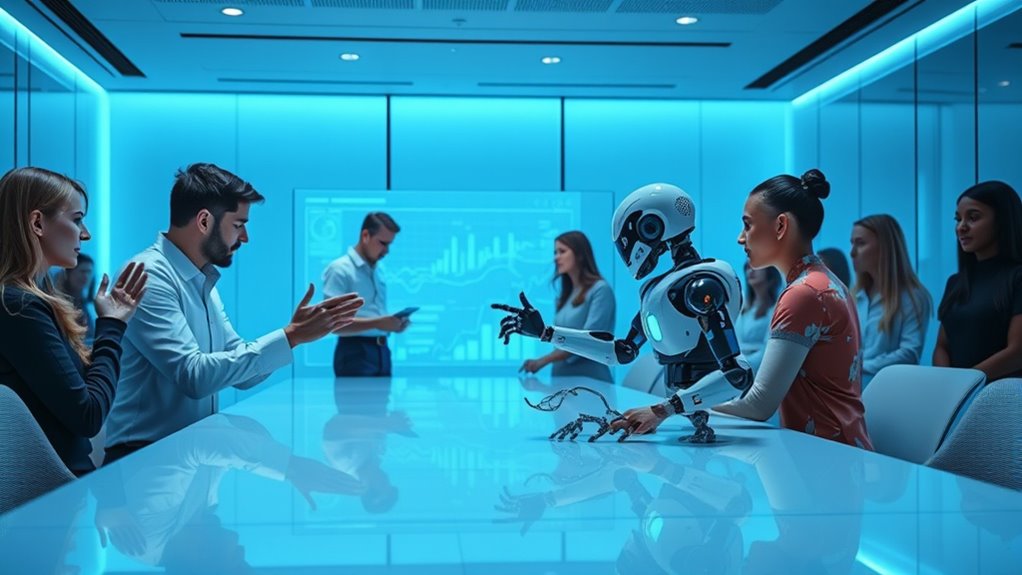In today’s workplace, you’re working alongside algorithms that act as teammates, helping you streamline tasks, analyze data, and generate insights. AI tools boost your productivity and improve workflows, but also change how teams communicate and collaborate. As you adapt to these tech partners, you may notice shifts in team dynamics, face new challenges, and need to develop digital skills. If you keep exploring, you’ll discover how these changes are shaping your work environment.
Key Takeaways
- AI tools streamline tasks, enhance data analysis, and generate insights, transforming traditional teamwork dynamics.
- Algorithms serve as collaborative teammates, improving productivity and decision-making in hybrid and remote work environments.
- Seamless AI integration reduces communication overload and technical glitches, fostering more effective collaboration.
- Developing digital skills and adapting workflows are essential as AI becomes an integral part of team interactions.
- Embracing AI as a teammate can boost employee engagement, customer satisfaction, and overall organizational performance.

As workplaces evolve, collaboration now extends beyond human colleagues to include AI as a vital partner. You’re likely working alongside AI tools that help streamline tasks, analyze data, and generate insights, making your workflow more efficient. While AI enhances productivity, it also shifts how you interact with your team. You might notice fewer face-to-face conversations, which can increase feelings of loneliness and emotional fatigue. This emotional strain can lead to counterproductive work behaviors, affecting both your performance and team dynamics. Fortunately, leaders who provide emotional support can help reduce these negative effects, fostering a healthier collaboration environment.
Remote and hybrid work models are reshaping collaboration even further. About half of remote-capable employees now work in hybrid setups, while a quarter do so fully remotely. More job postings are now offering remote options, with roughly 25% being hybrid roles. Meanwhile, traditional onsite roles have declined from 83% to 66%. Despite these shifts, many employees feel managers favor in-office workers, perceiving them as more dedicated or trustworthy. The constant flow of emails, chats, and meetings also hampers collaboration efficiency. On average, employees lose at least three hours weekly due to these inefficiencies, with some losing up to six hours. These mismatches between expectations and reality stem from tool limitations and evolving team structures, demanding new digital skills and adaptable workflows.
Familiarity with AI tools is high, with 94% of employees and 99% of executives aware of generative AI. However, comfort levels vary, with only 16% to 67% feeling extensively familiar. Those who use AI personally tend to be more comfortable and plan to increase their AI usage at work. Many recognize the benefits—75% of leaders with AI-enabled teams report improved collaboration, which can boost customer satisfaction and profitability. Still, communication remains a challenge; nearly a third of employees find it harder to connect with colleagues and clients, and technical glitches cause frequent delays. With over 100 apps used within a typical company, digital overload persists, underscoring the need for smarter, streamlined collaboration strategies that integrate AI seamlessly into daily workflows. The proliferation of digital tools emphasizes the importance of adopting integrated solutions that reduce friction and support effective teamwork.
Frequently Asked Questions
How Do Workers Feel About Collaborating With Algorithms?
You might feel a mix of excitement and skepticism about collaborating with algorithms. Many workers are already familiar with AI, with some feeling optimistic and others cautious or skeptical. If you’re open to it, you may see AI as a helpful teammate that improves your work outcomes. However, concerns about emotional strain, loss of control, or responsibility shifting can cause resistance. Overall, attitudes vary, but most employees engage actively with AI tools.
What Skills Are Essential for Effective Human-Algorithm Teamwork?
You need strong communication skills to explain complex AI concepts clearly. Cultivate data literacy to interpret AI outputs accurately and understand data quality. Develop prompt engineering skills to craft precise instructions guiding AI effectively. Enhance critical thinking to evaluate AI insights for bias or errors. Practice ethical judgment to guarantee responsible use of AI, respecting privacy and fairness. Combining these skills helps you work seamlessly with algorithms, making collaboration productive and trustworthy.
How Do Algorithms Impact Job Security and Employment Rates?
You might think algorithms threaten your job security, but they also create new opportunities. While up to 50% of entry-level roles could vanish, AI fosters the emergence of 170 million new jobs worldwide, especially in tech, healthcare, and education. By reskilling and adapting, you can stay ahead, as many roles evolve rather than disappear. Embracing AI as a partner rather than a threat helps you secure your employment future.
What Ethical Considerations Arise From Human-Algorithm Collaboration?
When collaborating with algorithms, you face ethical concerns about bias, privacy, and autonomy. You need transparency to understand how decisions are made, guaranteeing fairness and avoiding discrimination. Protecting employee privacy is vital, so clear data use policies matter. Human oversight is essential to prevent overreliance on automation, preserving your agency and accountability. Balancing efficiency with ethical standards helps foster trust and guarantees that AI acts as a responsible teammate rather than a substitute.
How Will This Collaboration Change Workplace Dynamics Long-Term?
This collaboration will transform workplace dynamics by emphasizing human skills like creativity, emotional intelligence, and complex problem-solving, which AI can’t replicate. You’ll see roles hybridize, blending AI competencies with domain expertise. Hybrid work models will become the norm, with AI tools improving communication and workflow. Over time, organizations will value collaboration between humans and algorithms, fostering innovation, inclusivity, and a culture that adapts quickly to technological changes.
Conclusion
As you embrace this new way of working, remember that algorithms can be your allies, not just your tools. While machines process data at lightning speed, your creativity and empathy remain irreplaceable. It’s a partnership where human ingenuity and technology complement each other, creating a future full of possibilities. In this collaboration, you don’t lose your humanity—you amplify it. Together, you and the algorithms can achieve what neither could alone, forging a more innovative and compassionate workplace.











